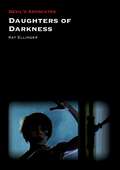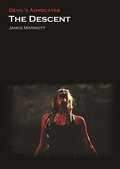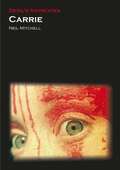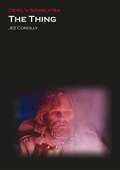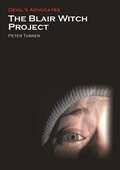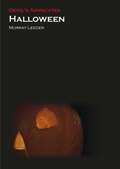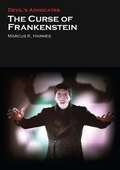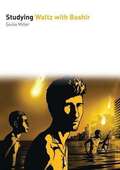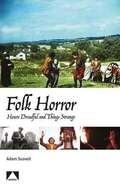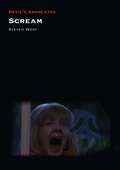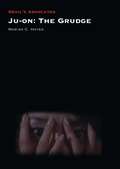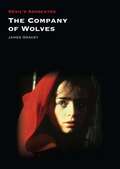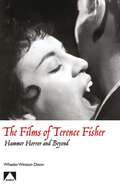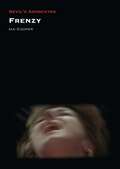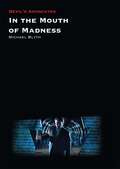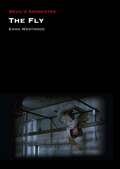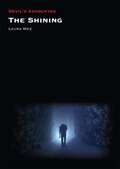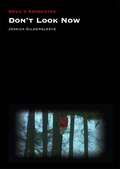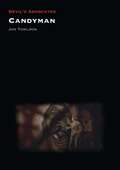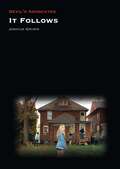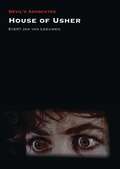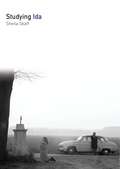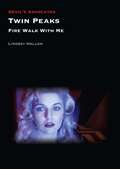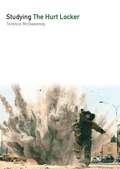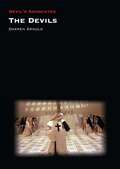- Table View
- List View
Daughters of Darkness (Devil's Advocates)
by Kat EllingerDaughters of Darkness (1971) is a vampire film like no other. Heralded as psychological high-Gothic cinema, loved for its art-house and erotic flavors, Harry Kümel's 1971 cult classic is unwrapped in intricate detail by writer Kat Ellinger to unravel the many mysteries surrounding just what makes it so appealing. This book, as part of the Devil’s Advocates series, examines the film in the context of its peers and contemporaries, in order to argue its place an important evolutionary link in the chain of female vampire cinema. The text also explores the film's association with fairy tales, the Gothic genre, and fantastic tradition, as well as delving into aspects of the legend of Countess Bathory, traditional vampire lore, and much more. The book contains new and exclusive interviews with director Harry Kümel and actress and star Danielle Ouimet.
The Descent (Devil's Advocates)
by James MarriottThe story of an all-female caving expedition gone horribly wrong, The Descent (2005) is arguably the best of the mid-2000s horror entries to return verve and intensity to the genre. Unlike its peers (Saw [2004], Hostel [2011], etc.), The Descent was both commercially and critically popular, providing a genuine version of what other films could only produce as pastiche. For Mark Kermode, writing in the Observer, it was "one of the best British horror films of recent years," and Derek Elley in Variety described it as "an object lesson in making a tightly-budgeted, no-star horror pic." Time Out's critic praised "this fiercely entertaining British horror movie;" while Rolling Stone's Peter Travers warned prospective viewers to "prepare to be scared senseless." Emphasizing female characters and camaraderie, The Descent is an ideal springboard for discussing underexplored horror themes: the genre's engagement with the lure of the archaic; the idea of birth as the foundational human trauma and its implications for horror film criticism; and the use of provisional worldviews, or "rubber realities," in horror.
Carrie (Devil's Advocates)
by Neil MitchellBrian De Palma's adaptation of Stephen King's debut novel, Carrie (1976), is one of the defining films of 1970s "New Hollywood" style and a horror classic. The story of a teenage social outcast who discovers she possesses latent psychic powers that allow her to deliver retribution to her peers, teachers, and abusive mother, Carrie was an enormous commercial and critical success and is still one of the finest screen adaptations of a King novel. This contribution to the Devil's Advocates series not only breaks the film down into its formal componenets--its themes, stylistic tropes, technical approaches, uses of color and sound, dialogue, and visual symbolism--but also considers a multitude of other factors contributing to the work's classic status. The act of adapting King's novel for the big screen, the origins of the novel itself, the place of Carrie in De Palma's oeuvre, the subsequent versions and sequel, and the social, political, and cultural climate of the era (including the influence of second wave feminism, loosening sexual norms, and changing representations of adolescence), as well as the explosion of interest in and the evolution of the horror genre during the decade, are all shown to have played an important part in the film's success and enduring reputation.
The Thing (Devil's Advocates)
by Jez ConollyConsigned to the deep freeze of critical and commercial reception upon its release in 1982, The Thing has bounced back spectacularly to become one of the most highly regarded productions from the 1980s 'Body Horror' cycle of films, experiencing a wholesale and detailed reappraisal that has secured its place in the pantheon of modern cinematic horror. Thirty years on, and with a recent prequel reigniting interest, Jez Conolly looks back to the film's antecedents and to the changing nature of its reception and the work that it has influenced. The themes discussed include the significance of The Thing's subversive antipodal environment, the role that the film has played in the corruption of the onscreen monstrous form, the qualities that make it an exemplar of the director's work and the relevance of its legendary visual effects despite the advent of CGI. Topped and tailed by a full plot breakdown and an appreciation of its notoriously downbeat ending, this exploration of the events at US Outpost 31 in the winter of 1982 captures The Thing's sub-zero terror in all its gory glory.
The Blair Witch Project (Devil's Advocates)
by Peter TurnerFew films have had the influence and impact of The Blair Witch Project (1999). Its arrival was a horror cinema palette cleanser after a decade of serial killers and postmodern intertextuality, a bare bones 'found footage' trend setter. In this Devil's Advocate, Peter Turner tells the story of the film from his conception and production then provides a unique analysis of the techniques used, their appeal to audiences and the themes that helped make the film such an international hit, including the pionerring internet marketing.
Halloween (Devil's Advocates)
by Murray LeederThe 1970s represented an unusually productive and innovative period for the horror film, and John Carpenter's Halloween (1978) is the film that capped that golden age – and some say ruined it, by ushering in the era of the slasher film. Considered a paradigm of low-budget ingenuity, its story of a seemingly unremarkable middle-American town becoming the site of violence on October 31 struck a chord within audiences. The film became a surprise hit that gave rise to a lucrative franchise, and it remains a perennial favourite. Much of its success stems from the simple but strong constructions of its three central characters: brainy, introverted teenager Laurie Strode, a late bloomer compared to her more outgoing friends, Dr. Loomis, the driven, obsessive psychiatrist, and Michael Myers, the inexplicable, ghostlike masked killer.Film scholar Murray Leeder offers a bold and provocative study of Carpenter's film, which hopes to expose qualities that are sometime effaced by its sequels and remakes. It explores Halloween as an unexpected ghost film, and examines such subjects as its construction of the teenager, and the relationship of Halloween the film to Halloween the holiday, and Michael Myers's brand of "pure evil." It is a fascinating read for scholars and fans alike.
The Curse of Frankenstein (Devil's Advocates)
by Marcus HarmesCritics abhorred it, audiences loved it, and Hammer executives where thrilled with the box office returns: The Curse of Frankenstein was big business. The 1957 film is the first to bring together in a horror movie the 'unholy two', Christopher Lee and Peter Cushing, together with the Hammer company, and director Terence Fisher, combinations now legendary among horror fans. In his Devil's Advocate, Marcus Harmes goes back to where the Hammer horror production started, looking at the film from a variety of perspectives: as a loose literaryadaptation of Mary Shelley's novel; as a film that had, for legal reasons, to avoid adapting from James Whale's 1931 film for Universal Pictures; and as one which found immediate sources of inspiration in the Gainsborough bodice rippers of the 1940s and the poverty row horrors of the 1950s. Later Hammer horrors may have consolidated the reputation of the company and the stars, but these works had their starting point in the creative and commercial choices made by the team behind The Curse of Frankenstein. In the film sparks fly, new life is created and horrors unleashed but the film itself was a jolt to 1950s cinema going that has never been entirely surpassed.
Studying Waltz with Bashir (Studying Films)
by Giulia MillerOn its release in 2008, Ari Folman's animated documentary Waltz with Bashir was heralded as a brilliant and original exploration of trauma, and trauma's impact on memory and the recording of history. But it is surprising that although the film is seen through the eyes of one particular soldier, a viewpoint portrayed using highly experimental forms of animation, this has not prevented Waltz with Bashir from being regarded as both an "autobiographical" and "honest" account of the director's own experiences in the 1982 Lebanon war. In fact, the film won several documentary awards, and even those critics focusing on the representation of trauma suggest that this trauma must be authentic. In this sense, it is the documentary form rather than the animation that has had the most influence upon critics.As Studying Waltz with Bashir will show, it is the tension between the two forms that makes the film so complex and interesting, allowing for multiple themes and discourses to coexist, including Israel's role during the Lebanon War and the impact of trauma upon narrative, but also the representation of Holocaust memory and its role in the formation of Israeli identity. In addition to these themes that coexist by virtue of the film's unusual animated documentary format, Waltz with Bashir can also be discussed in relation to a broad range of contexts; for example, the representation of war in film, the history of Israeli Holocaust cinema, and recent trends in experimental animation, such as Richard Linklater's Waking Life (2001) and A Scanner Darkly (2006), as well as Folman's most recent live action/animation work The Congress (2013).
Folk Horror: Hours Dreadful and Things Strange (Auteur)
by Adam ScovellInterest in the ancient, the occult, and the "wyrd" is on the rise. The furrows of Robin Hardy (The Wicker Man), Piers Haggard (Blood on Satan's Claw), and Michael Reeves (Witchfinder General) have arisen again, most notably in the films of Ben Wheatley (Kill List), as has the Spirit of Dark of Lonely Water, Juganets, cursed Saxon crowns, spaceships hidden under ancient barrows, owls and flowers, time-warping stone circles, wicker men, the goat of Mendes, and malicious stone tapes.Folk Horror: Hours Dreadful And Things Strange charts the summoning of these esoteric arts n the latter half of the twentieth century and beyond, using theories of psychogeography, hauntology, and topography to delve into the genre's output in film, television, and multimedia as its "sacred demon of ungovernableness" rises yet again in the twenty-first century.
Scream (Devil's Advocates)
by Steven WestWes Craven's Scream (1996) emerged at the point where the early eighties American slasher cycle had effectively morphed into the post-Fatal Attraction trend for Hollywood thrillers that incorporated key slasher movie tropes. Scream emerged as a spiritual successor to Wes Craven's unpopular but critically praised previous film New Nightmare (1994), which evolved from his frustration at having lost creative control over his most popular creation, Freddy Krueger, and rebirthed the character in a postmodern context. Scream appropriates many of the concepts, conceits, and in-jokes inherent in New Nightmare, albeit in a much more commercial context that did not alienate teenage audiences who were not around to see the movies that were being referenced. This Devil's Advocate offers a full exploration of Scream, including its structure, its many reference points (such as the prominent use of Halloween as a kind of sacred text), its marketing ("the new thriller from Wes Craven" – not a horror film), and legacy for horror cinema in the new millennium.
Ju-On: The Grudge (Devil's Advocates)
by Marisa HayesTakashi Shimizu's Ju-on franchise was a principal instigator in the rise of contemporary Japanese horror and its international popularity at the turn of the millennium. Following the success of Hideo Nakata's Ringu (1998), the first cinematic release of Ju-on: The Grudge in 2002 crystallized Japanese horror's rise to prominence and outlined the new decade's thematic interest in supernatural technology and fear of contagions, while skillfully navigating domestic social concerns, such as Japan's growing elderly population and domestic violence.This Devil's Advocate explores the production roots of Ju-on The Grudge, followed by a critical reading of the film that highlights its essential themes and motifs, in addition to a section on cultural influences, before concluding with a section on Shimizu's continued involvement with the Ju-on franchise and its ongoing legacy. The book serves as an excellent primer for readers without prior knowledge of Japanese horror or the Ju-on film cycle, while providing fresh perspectives on the film that makes it equally appealing to J-horror aficionados.
The Company of Wolves (Devil's Advocates)
by James GraceyCo-written by Irish filmmaker Neil Jordan and British novelist Angela Carter, and based on several short stories from Carter's collection The Bloody Chamber, The Company of Wolves (1984) is a provocative reinvention of the fairy tale of Little Red Riding Hood. Unraveling a feverish metaphor for the blossoming of a young girl's sexuality and her subsequent loss of innocence, the film entwines symbolism and metaphor with striking visuals and grisly effects. Released in the early 1980s, a time which produced several classic werewolf films (including An American Werewolf in London and The Howling), The Company of Wolves sets itself apart from the pack with its overtly literary roots, feminist stance, and art-house leanings. The film's narrative takes the form of a puzzle box, unfolding as dreams within dreams, and stories within stories, which lead further into the dark woods of the protagonist's psyche, as she finds herself on the cusp of womanhood. This Devil's Advocate explores all these aspects, as well as placing the film in the context of the careers of its creators and its position as an example of the "Female Gothic."
The Films of Terence Fisher: Hammer Horror and Beyond (Auteur)
by Wheeler Winston DixonTracing the entire career of the British director Terence Fisher, best known for his Gothic horror films for Hammer—such as The Curse of Frankenstein (1957) and Dracula (1958)—The Films of Terence Fisher covers not only his horror films, but also his film noirs, comedies, and early apprenticeship work to create a full picture of Fisher's life and work.Brimming with rare stills, interviews, and detailed analysis of Fisher's films—both for Hammer as well as his earlier work—this is the ultimate "one-stop" book on Terence Fisher, both in his horror films, and his entire body of work, as well as his legacy to the British cinema.
Frenzy (Devil's Advocates)
by Ian CooperFrenzy (1972) was Alfred Hitchcock's penultimate film, and arguably one of his most misunderstood and neglected. Whereas even Psycho (1960) did eventually become respectable – indeed, it's a good contender for the most admired of the Master's films - Frenzy still remains problematic for many. While Raymond De Foery makes his feelings clear in the title of his book, Alfred Hitchcock's Frenzy: The Last Masterpiece, Hitchcock's controversial biographer Donald Spoto calls the film "repulsive" and "a closed and coldly negative vision of human possibility". Frenzy is perhaps Hitchcock's most nakedly autobiographical film, representing both a comeback and farewell to the city of his birth. But it started out as a very different kind of project. This Devil's Advocate discusses the evolution of the film, its production, reception, and place in Hitchcock's oeuvre, as well as its status as a key film of "sleazy Seventies" British cinema.
In the Mouth of Madness (Devil's Advocates)
by Michael BlythSomewhat overlooked upon its initial release in 1995, John Carpenter's In the Mouth of Madness has since developed a healthy cult reputation. But far more than simply a fan favorite, this closing installment of the acclaimed director's self-described "apocalypse trilogy" (following The Thing and Prince Of Darkness) stands today as one of his most thematically complex and stylistically audacious pieces of work.The story of an insurance investigator drawn into the supposedly fictional universe of a best-selling horror novelist, the film is an extension of many recurring themes found in Carpenter's filmography (the end of the world, the loss of free will, a distrust of mass industry and global corporations, the cataclysmic resurgence of ancient evil), as well as an affectionate homage to the works of H. P. Lovecraft (and horror literature more broadly) and a self-reflexive celebration of the horror genre that predates the Scream-inspired postmodernist boom of late-'90s genre cinema. While numerous books and countless academic essays have been written about Carpenter's work, surprisingly little has focused exclusively on In the Mouth of Madness, a film which feels more prescient, more essential, and more daringly complex than ever. This book seeks to redress this imbalance, at last positioning this overlooked masterpiece as essential Carpenter.
The Fly (Devil's Advocates)
by Emma WestwoodIt's not often that a remake outshines its original but David Cronenberg's "reimagining" of The Fly (1986) is one of those rare exceptions. Equal parts horror, science fiction, and romance, The Fly takes the premise of its 1958 original—a man unintentionally fusing with a housefly during an experiment in teleportation—and reinterprets the plot as a gradual cellular metamorphosis between these two organisms.This book teases out the intricate DNA of The Fly and how it represents the personalities of many authors, including a distinguished history of Man-as-God tales stretching back to Mary Shelley's Frankenstein (1818). Drawing from interviews with cast, crew, film commentators, and other filmmakers, Emma Westwood interlaces the "making of" travails of The Fly with why it is one of the most important examples of master storytelling ever committed to screen.
The Shining (Devil's Advocates)
by Laura MeeTaking a fresh look at The Shining (1980), this book situates the film within the history of the horror genre and examines its rightful status as one of the greatest horror movies ever made. It explores how Stanley Kubrick's filmmaking style, use of dark humor, and ambiguous approach to supernatural storytelling complements generic conventions, and it analyzes the effective choices made in adapting King's book for the screen—stripping the novel's backstory, rejecting its clear explanations of the Overlook Hotel's hauntings, and emphasizing the strained relationships of the Torrance family. The fractured family unit and patriarchal terror of Kubrick's film, alongside its allusions to issues of gender, race, and class, connect it to themes prevalent in horror cinema by the end of the 1970s, and are shown to offer a critique of American society that chimed with the era's political climate as well as its genre trends. The film's impact on horror cinema and broader pop culture is ever apparent, with homages in everything from Toy Story to American Horror Story. The Shining showed that popular, commercial horror films could be smart, artistic, and original.
Don't Look Now (Devil's Advocates)
by Jessica GildersleeveNicolas Roeg's Don't Look Now (1973) has been called "a ghost story for adults." Certainly, in contrast to the more explicitly violent and bloodthirsty horror films of the 1970s, Don't Look Now seems of an entirely different order. Yet this supernaturally inflected tale of a child's accidental drowning, and her parents' desperate simultaneous recoil from her death and pursuit of her ghost, Don't Look Now is horrific at every turn. This book argues for it as a particular kind of horror film, one which depends utterly on the narrative of trauma—on the horror of unknowing, of seeing too late, and of the failures of paternal authority and responsibility. Jessica Gildersleeve positions Don't Look Now within a discourse of midcentury anxiety narratives primarily existing in literary texts. In this context, it represents a cross over or a hinge between literature and film of the 1970s, and the ways in which the women's ghost story or uncanny story turns the horror film into a cultural commentary on the failures of the modern family.
Candyman (Devil's Advocates)
by Jon TowlsonWhen Candyman was released in 1992, Roger Ebert gave it his thumbs up, remarking that the film was “scaring him with ideas and gore, rather than just gore.” Indeed, Candyman is almost unique in 1990s horror cinema in that it tackles its sociopolitical themes head on. As critic Kirsten Moana Thompson has remarked, Candyman is "the return of the repressed as national allegory": the film’s hook-handed killer of urban legend embodies a history of racism, miscegenation, lynching, and slavery, "the taboo secrets of America’s past and present."In this book, Jon Towlson considers how Candyman might be read both as a "return of the repressed" during the George H. W. Bush era, and as an example of nineties neoconservative horror. He traces the project’s development from its origins as a Clive Barker short story ("The Forbidden"); discusses the importance of its gritty real-life Cabrini-Green setting; and analyzes the film’s appropriation (and interrogation) of urban myth. The two official sequels (Candyman: Farewell to the Flesh [1995] and Candyman: Day of the Dead [1999]) are also considered, plus a number of other urban myth-inspired horror movies such as Bloody Mary (2006) and films in the Urban Legend franchise. The book features an in-depth interview with Candyman’s writer-director Bernard Rose.
It Follows (Devil's Advocates)
by Josh GrimmAmid a recent resurgence in horror films, David Robert Mitchell’s It Follows stands out as a particularly bold entry, a horror fan’s dream come true that sparked a renewed creativity. Pulling a robust 97% on Rotten Tomatoes, It Follows was hailed as a “teen movie you’ve never seen before,” a “creepy, mesmerizing exercise in minimalist horror,” “the best horror film in years,” and simply, “so damn good.” Mitchell uses a variety of approaches to reinvent genre bromides while simultaneously embracing and challenging tropes that audiences and filmmakers rely on a little too heavily. It Follows is one of the best because it is one of the most unique. In this Devil’s Advocate, Joshua Grimm focuses on how this film helped reinvent the rules of a horror movie, particularly along the lines of genre, style, sex, and gender.
House of Usher (Devil's Advocates)
by Evert van LeeuwenDespite being the product of Roger Corman’s AIP exploitation studio, House of Usher enjoys a high standing. But while the impact and cult status of Corman’s Edgar Allan Poe cycle is often discussed in histories of gothic, horror, and exploitation cinema, no extended analysis and critical discussion has been published to date that explores specifically the aesthetic appeal of House of Usher. This Devil’s Advocate provides a complete study of the aesthetic appeal of Corman’s influential first Poe picture.Evert van Leeuwen explores the underlying narrative structure borrowed from Poe’s original story and shows how closely Richard Matheson’s script followed Poe’s theory of short fiction. He goes on to explore the formal techniques of allegory and symbolism employed to represent the house as a monster before focusing on Corman’s imagery, showing how the use of specific camera angles, lenses, colors, and sound effects create and sustain the simultaneously morbid and beautiful atmosphere of gothic decay. Finally, he situates horror icon Vincent Price’s performance as Roderick Usher in the context of the nineteenth-century Romantic misfit and the postwar countercultural antihero, two closely related cultural identities.
Studying Ida (Studying Films)
by Sheila SkaffPaweł Pawlikowski’s 2013 film Ida was exceptionally warmly received in the United States, culminating in the Academy Award for Film Not in the English Language, but it was not without controversy. Sheila Skaff’s introduction to the film explains the historical setting, including the violence that took place in the Polish countryside during World War II and was not exposed for sixty years, and provides political and cultural analysis to aid the reader in understanding the film’s setting and narrative. Skaff also touches on the influence of the film on current events in Poland, where censorship of it by an increasingly nationalist government has polarized the country. It also situates Ida within the contexts of Polish and world film history. Scene-by-scene analysis is accompanied in each chapter by background information that gives context to the aesthetic and narrative choices made by the director.
Twin Peaks: Fire Walk with Me (Devil's Advocates)
by Lindsay HallamWhen David Lynch’s film Twin Peaks: Fire Walk with Me, a prequel to the television series Twin Peaks, premiered at the 1992 Cannes Film Festival it was met with met with outright hostility. Subsequent reviews from critics were almost unanimously negative, and many fans of the show felt betrayed, as their beloved town was suddenly revealed as a personal hell. Yet in the years since the film’s release, there has begun to be a gradual wave of reappraisal and appreciation, one that accelerated with the broadcast of Twin Peaks: The Return in 2017. What has been central to this reevaluation is the realization that what Lynch had created was not a parody of soap opera and detective television but a horror movie.In this Devil’s Advocate, Lindsay Hallam argues that the horror genre aids Lynch’s purpose in presenting the protagonist Laura Palmer’s subjective experience leading to her death as the incorporation of horror tropes actually leads to a more accurate representation of a victim’s suffering and confusion. She goes on to explore how the film was an attempt by Lynch to take back ownership of the material and to examine the initial reaction and subsequent reevaluation of the film, as well as the paratexts that link to it and the influence that Fire Walk with Me now has on contemporary film and across popular culture.
Studying The Hurt Locker (Studying Films)
by Terence McSweeneyIn this vibrant and dynamic book-length study drawing on a broad tapestry of research, Terence McSweeney offers an exploration of The Hurt Locker (2009), its stylistic and narrative devices, its cultural impact, its reception, and its relationship to the genre of the war film. McSweeney places the film in a richly textured historical, political, and industrial context, arguing that The Hurt Locker is part of a long tradition of films about American wars that play a considerable role in how audiences come to understand the conflicts that they depict. Thus, films about a nation’s wars are never “only a movie” but rather should be considered a cultural battleground themselves on which a war of representation is waged.
The Devils (Devil's Advocates)
by Darren ArnoldUndoubtedly the most notorious title in director Ken Russell’s controversial filmography, The Devils (1973) caused a real furor on its initial theatrical release, only to largely disappear for many years. This Devil’s Advocate considers the film’s historical context, as the timing of the first appearance of The Devils is of particular importance, its authorship and adaptation (Russell’s auteur reputation aside, the screenplay is based on John Whiting’s 1961 play of the same name, which was in turn based on Aldous Huxley’s 1952 book The Devils of Loudun), and its generic hybridity. Darren Arnold goes on to examine the themes prevalent in the film—this is the only film of Russell’s which the director considered to be political—and considers the representation of gender and sexuality, gender fluidity, and how sex and religion clash to interesting and controversial effect. He concludes by revisiting the film’s censorship travails and the various versions of The Devils that have appeared on both big and small screens, and the film’s legacy and influence.
